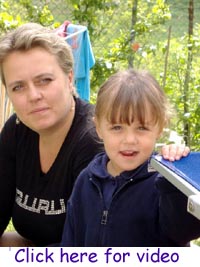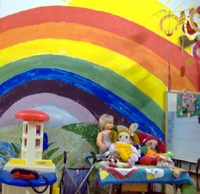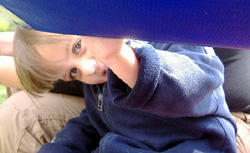 |
|
 It’s 9 a.m. Monday, and 3-year-old Iris Curci is on her way to la Scuola Materna, the kindergarten in Cagli, Italy. In one hand she carries a green button-down smock and in the other she holds a doll. The smock is to distinguish which of the five classes she belongs in. The doll is to share with the other students, a customary practice in her school. Iris’ mother, Sonia Vandini, helps her daughter into the car and begins to drive toward Old Cagli, where the school is located. It’s 9 a.m. Monday, and 3-year-old Iris Curci is on her way to la Scuola Materna, the kindergarten in Cagli, Italy. In one hand she carries a green button-down smock and in the other she holds a doll. The smock is to distinguish which of the five classes she belongs in. The doll is to share with the other students, a customary practice in her school. Iris’ mother, Sonia Vandini, helps her daughter into the car and begins to drive toward Old Cagli, where the school is located.
By 9:15 Iris walks through the large wooden doors of her school and makes her way to her class, or section, as it is called in Italy. There she is surrounded by 3 and 4-year-old boys and girls in green shirts, sitting around small tables or playing on the carpeted floor. Many of the children have arrived before Iris, some as early as 8 a.m., to begin their day. Lugina and Marilena, Iris’ two teachers, assist her as she settles into her surroundings and prepares for the rest of the day. By 9:30 the class is full, with about 25 children settled around the colorful room.
In La Scuola Materna there are no textbooks or tests. There is no homework to check or assignments to complete. Instead, the children learn by playing, through activities and group projects, and through games that are meant to teach.
“Children do not think the way adults do, so it is important that we teach them as children,” said Patrizia Capodicasa, a teacher in La Scuola Materna.
Iris’ class is clearly meant for young students. There are games on the shelves, toys on the floor, and bright posters and decorations on the walls. Many of the decorations were created by the students themselves. On one of the tables is a small sandbox, complete with shovels and large yellow trucks. Iris, however, makes her way to another table, one with a box of crayons and some paper. |
 “Iris’ favorite thing to do in school is to draw,” said Sonia Vandini about her daughter. This works out well for Iris because much of her school day is filled with arts and crafts. During holidays there are special projects for the children to work on. Each day all the students in La Scuola Materna also work on a special themed project, which will be displayed in the Cagli middle school at the end of the year. The current theme, which changes each year, is flowers. Iris and her classmates take time during the day to work on this flower project as part of the larger collaboration. Activities such as this help to socialize the children, to teach them how to bond and to cooperate with each other. “Iris’ favorite thing to do in school is to draw,” said Sonia Vandini about her daughter. This works out well for Iris because much of her school day is filled with arts and crafts. During holidays there are special projects for the children to work on. Each day all the students in La Scuola Materna also work on a special themed project, which will be displayed in the Cagli middle school at the end of the year. The current theme, which changes each year, is flowers. Iris and her classmates take time during the day to work on this flower project as part of the larger collaboration. Activities such as this help to socialize the children, to teach them how to bond and to cooperate with each other.
“All time is useful for something,” said Capodicasa. “Activities are used for teaching. Even free time for the children serves a purpose.” La Scuola Materna teaches the children proper ways of behaving and prepares them for their next level of education. The school sees politeness, concentration, civility and respect as the most important things for young children to learn. Part of teaching these things in la Scuola Materna involves finding ways to adapt to the minds of the children. Capodicasa used the term “strategies” when describing their methods. “The children do not understand the concept of time, so we associate days of the week with colors. Then when the kids talk about a certain day, they think of a color and it helps them to remember.”
At one point during the day most of the children separate to learn lessons in Catholicism, something that the parents choose for their children. For those who are not Catholic, there are other activities. Iris’ family has chosen for her to be raised Catholic, and so she goes with the first group of students to study lessons from the Bible and to acquire the basic principles of Christianity. She may sing songs or draw pictures to help her learn the lessons. |
 By 11:45 a.m. the children are getting hungry, but luckily for them it’s time for lunch. Some of them go home to eat, but others, like Iris, stay at the school, where they are served two courses, usually with pasta and a type of meat. Lunchtime is a very important time for the people of Cagli, and so it is for the children as well. In about an hour the children will return to their class activities. By 11:45 a.m. the children are getting hungry, but luckily for them it’s time for lunch. Some of them go home to eat, but others, like Iris, stay at the school, where they are served two courses, usually with pasta and a type of meat. Lunchtime is a very important time for the people of Cagli, and so it is for the children as well. In about an hour the children will return to their class activities.
As children return to the school and the others finish their lunch, Iris finds a seat on the floor with her friends to begin story time. Either Lugina or Marilena reads books to the children to entertain them and also help them learn. In two more years Iris will begin learning how to read, but for now she is happy with listening to the stories that her teachers read to her.
Soon it is after 1 p.m. and some of the students are beginning to leave. Parents may begin picking up their children between 1 and 2 p.m. and again between 3:30 and 4 p.m.. Iris usually leaves just before 2 p.m.. One of her parents will come soon to pick her up and until then she occupies herself by playing with her doll and stacking blocks on the floor. When her mother finally arrives and she begins to leave, the classroom rings with the voices of her classmates.
“Ciao, Iris, a domani, martedì verde!” This little phrase is said to each student as he or she leaves the school. Literally translated it means, “Goodbye, Iris, until tomorrow, green Tuesday.” As an example of one of the “strategies” mentioned by Capodicasa, the children associate the color green with Tuesday as they tell their friend that they will see her the next day. Monday for Iris is over, and she heads home for the day, ready to return the next morning. |
|
[HOME] |
|
 |
